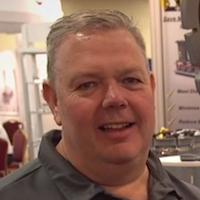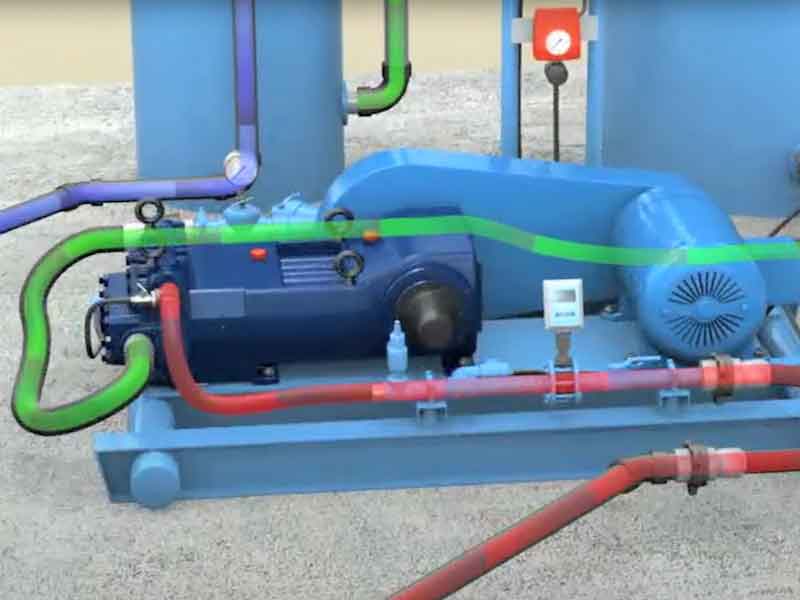Water consumption in the metal finishing and electronics industries has become an increasingly expensive commodity.
Re-use and re-cycle are policies now being encouraged by environmental organisations as a means of saving this precious resource. The results of adopting this policy include large potential savings for the electro-plater. With strategic handling, wastewater can be re-cycled back to the non-critical rinses, which will typically generate a 40 – 50 % reduction in water usage.
This paper looks at achieving this reduction by using a permanent media, automatic backwashing filter integrated into an effluent plant thereby providing a maintenance free method of re-cycling water. I will highlight a case history of such an installation and discuss how the filter fits into effluent plant, how the filter works, and the results in terms of payback on investment based on the reduction in water expenditure.
Introduction
 Huw WilliamsRe-cycle and Re-use are very much the “buzz words” these days. In all areas of our lives we are becoming more and more aware of precious resources, including water, oil, electricity, gas etc… We are increasingly asked to value these commodities and, wherever possible, maximise their effective use.
Huw WilliamsRe-cycle and Re-use are very much the “buzz words” these days. In all areas of our lives we are becoming more and more aware of precious resources, including water, oil, electricity, gas etc… We are increasingly asked to value these commodities and, wherever possible, maximise their effective use.
Industrial uses of these resources are of great concern to most countries, although in many areas their use has been taken for granted for many years. This paper deals with water usage in industry and looks at a cost beneficial method of achieving a significant reduction in water use through re-cycling and re-using.
Reasons to Recycle
Typically in our metal finishing industries, factories work on a “total loss” basis regarding water. That is to say, that water is bought into the factory and after use is treated and sent to drain (sewer). Therefore, as a processor you pay twice for the privilege. Once to buy and once to discharge.
European legislation relating to the re-cycling of water can be found in the IPPC (Integrated Pollution Prevention and Control) document as follows: IPPC S2.07 (paragraph 2.3.10.11) states that: - “secondary / tertiary treatment filtration is recommended to remove fine suspended solids to achieve trade effluent consent limits…effluent may be re-cycled to less critical rinsing steps and thus reduce input water”.
There are three main reasons to re-cycle water, which can be categorised as follows: environmental, commercial, and legislative.
Environmental
From an environmental point of view the most obvious physical result from re-cycling is to simply save water. Water is a precious resource which is taken for granted in many industrial areas and therefore, over the years, the demand has increased dramatically. Water is not a limitless resource.
Discharge from manufacturing companies nearly always contains some suspended solids and acceptable emission levels vary greatly from area to area. In companies where little thought is given to water usage and disposal, there is always the possibility of current levels being exceeded. Companies that do adopt a waste minimisation program, therefore, reduce the possibility of accidental discharge and the general level of pollution.
The integrity of local water treatment systems is also improved by reducing the amount of contaminated water discharging from factories.
Finally adopting rational and responsible conservation policies clearly improves the profile of our industrial sector.
Commercial Reasons to Recycle
The commercial benefits for companies who re-cycle and re-use water are clear. The cost of buying and discharging water is simply reduced in line with the percentage reduction in volume used. All the indicators at the moment suggest that the price of water will continue to rise for the foreseeable future, so potential savings will become even more important.
Attention to this subject demonstrates good housekeeping procedures within a company and often encourages a general ethos within the company to “work smarter”. As water is a total “overhead”, then any saving generates extra net profit.
Know Your Overheads
Our industry is more competitive than ever, not just companies in a local area competing for the same jobs, but the market is now global.
We cannot always control our sales; we are all somewhat market dependent although, with astute marketing and sales effort we can often generate extra revenue.
However, we can always control our costs. I can almost guarantee that if we analyse our overheads and investigate ways in which they can be reduced (even with an element of initial capital expenditure), there will be areas where we can reduce what we spend.
In the finishing industries water is a significant overhead and can be reduced in most cases.
Do the Maths
If you water bill is costing you $3500 per month, and capital investment of $21,000 to $26,000 facilitates a 50% re-cycle opportunity, then pay back on investment is 12 – 15 months.
Equipment
Virtually 99% of water purified in the world today is accomplished by passing the water through “rapid sand filters.” Theoretically, the upper layer of the bed performs the filtration, while the lower layers provide the necessary support and assist in the hydraulics involved during the backwash cycle.
The system includes a holding tank in line so that a filter may re-circulate the effluent. This makes it possible to improve the clarity with each pass, as more and more particles are removed. In other words, smaller and smaller solids are picked up.
Automatic Backwash, Permanent Media Filtration Systems
There are many types of sand filters available and this paper focuses on a system, which incorporates automatic valves, a flow meter, pump and PLC control system as shown in Figure 1.

During the filtration cycle the contaminated water is pumped through the upper manifold, through the media and exits the vessel through an arrangement of ‘laterals’ constructed to prevent the passage of media from the vessel. Also linked to the lower manifold is an arrangement of air laterals, which provide for media agitation during the backwash cycle.
The concept of the system is to provide a high average flow rate, which is maintained automatically. The flow meter pre-installed into the discharge pipe work is linked to a relay, which is site programmable and activates the backwash cycle to push the retained particulate from the collection chamber and clean the filter media for re-use.
The recommended relay point is 75% of the initial flow rate and the backwash is achieved by a collection of automatic valves opening and shutting to reverse the flow direction. Within the backwash cycle, the media is agitated with 20psi of compressed air to aid in the release of trapped particles.
The sequence of operation is, therefore, as follows:
Filtration/Re-circulation: Here the solution is pumped directly from the recirculation tank, through the filter and back to the recirculation tank. Particulates are being removed from solution in the normal manner. See Fig 2a.

Backwash (5 mins) including air agitation of media: The flow through the filter is reversed and the particulates are transferred to waste treatment. After five minutes have elapsed, the original flow is returned to the configuration of Fig. 2a.
Back to Filtration: See Fig. 2b

Periodic Media Clean: On some installations it is recommended that the media be cleaned periodically with sodium hypochlorite to maintain optimum conditions. See Fig 2c.

Why Automatic? Why Permanent Media?
Figure 3 illustrates that using an automatic system with back- washable media generates the high average flow rate without any manual intervention. This is a necessary feature to allow the system to fit an effluent plant operating on a continuous flow basis (with only minutes required for a complete backwash cycle, only a small holding tank is required for recirculation).

Filtration Media
The properties of the filtration media employed in the filter are very important to the efficiency of operation and the ease with which it can be backwashed. The media must be hard, not smooth and free form soluble particles. For purity the content of the following constituents must be less than 0.0001%:- Arsenic, Cadmium, Chromium, Cyanide, Copper, Nickel, Lead, Zinc and Mercury.
Recommended Media mesh sizes
|
DESCRIPTION |
U.S. MESH |
APPROVALS |
|
Sand – 45 - .55 mm |
40-30 |
AWWA 100-89 SPECS |
|
Gravel – 1/4" x 1/8" (#3) |
6-3 medium. |
AWWA 100-89 SPECS |
Other Media properties:
- Acid Solubility (AWWA B100-89) - 5% max
- Specific Gravity (AWWA B100-89)- 2.62% min
- Porosity (ASTM C30/37)- 38.35%
- Loss of Ignition (AFC Handbook) 0.69%
- Hour Absorption 0.48%
- Dry Unit Weight (PFC) 100.00 lbs/of
Case Study: Reviewing the Installation of an Automatic Permanent Media Filter as Described Above
Company Profile: Large, In-house Zinc Plating shop. The company manufactures grocery carts for DIY retailers and is based in Glenrothies near Edinburgh, Scotland. Zinc is deposited using Alkaline Non Cyanide chemistry and water usage prior to installation was 4 ½ million USG per annum.
Objectives and Justification
- To improve quality of discharge and ensure consent levels are continuously achieved
- Reduce water usage and save money
Flow Path
Figure 4 shows a schematic diagram of the effluent plant after integration of the automatic filtration system. The maximum outflow from the plating shop is 1200 GPH . pH correction to 9-9.5 is achieved in the neutralisation tank then the water is collected in the pumping tank from where it is pumped through 2 settlement tanks. The majority of settlement takes place in settlement tank 1 which is automatically de-sludged to filter press twice a day and further settlement takes place in settlement tank 2 which is automatically de-sludged to press once per day.
From settlement tank 2 the overflow is routed to the circulation tank. Prior to the installation of the filter, the overflow at this point was simply going to drain resulting in a total water loss situation.
The automatic filter is installed on this circulation tank. This circuit is a closed loop arrangement and continuously filters and re-filters the water in the circulation tank which is at the heart of the system.
The water from the circulation tank overflows to the re-cycle tank and at this point approx 400 GPH is directed back into the plating shop where it is used in non-critical rinses.
The backwash cycle is initiated automatically when a pre-set flow rate is detected and is completed in approximately 10 minutes. The effluent generated by the backwash is then directed back into the first stage settlement tank and the closed loop is maintained.
Results
- Discharge quality improved and since installation emission levels have never been exceeded
- Allowing for variations in outflow rates from the plating shop the total water used in the year prior to the installation was 4.5 million USG.
- After installation the volume of filtered, re-cycled water used in non-critical rinses was 2.3 million USG per annum
- This represents a saving of just over 51%
- Based on the project cost of buying and installing the filter the pay back was achieved in 1 year.
Summary: Why Recycle?
To summarise, it is clear that significant savings can be made in our industry in regards of water consumption. Legislators demand that wherever possible water should be re-cycled and re-used for the good of us all.
Our industry can be considered environmentally friendly if we adopt current technologies available to us, and further more the technology discussed in this paper is both easy and simple to incorporate within your existing plant set-up and is clearly self financing over a very short period of time.
For more information contact Huw Williams, Global General Manager, SERFILCO Ltd., at 1-847-509-2900, or by email at hwilliams@serfilco.com




































